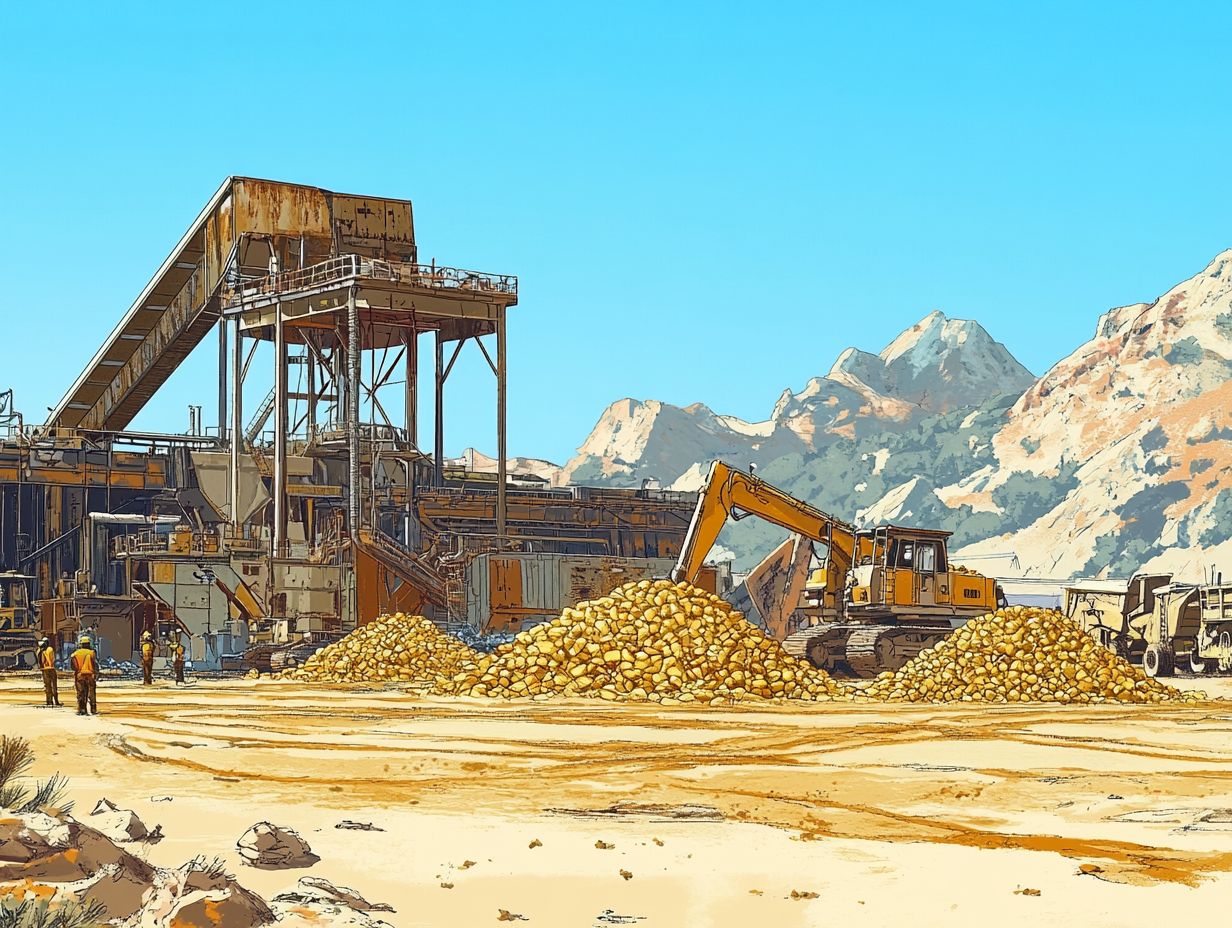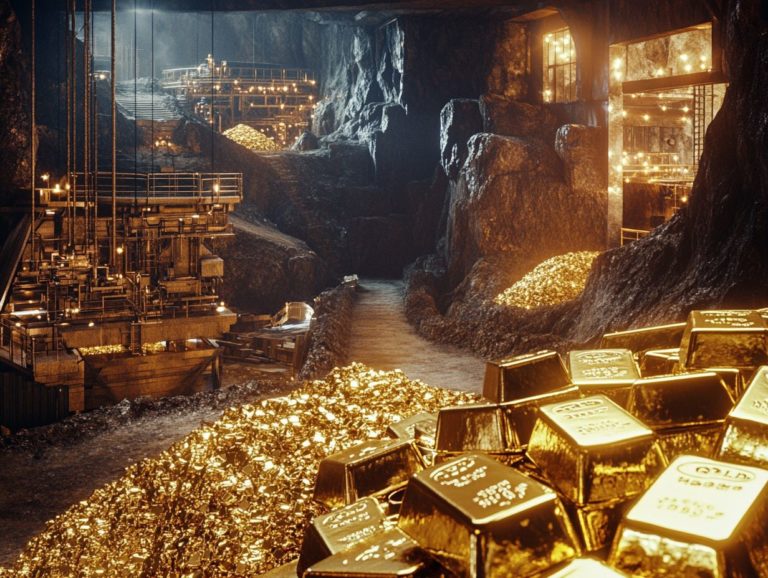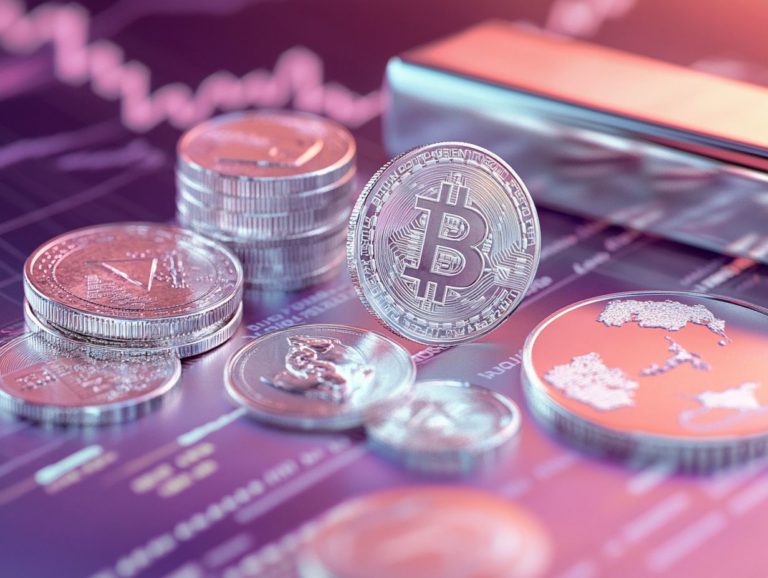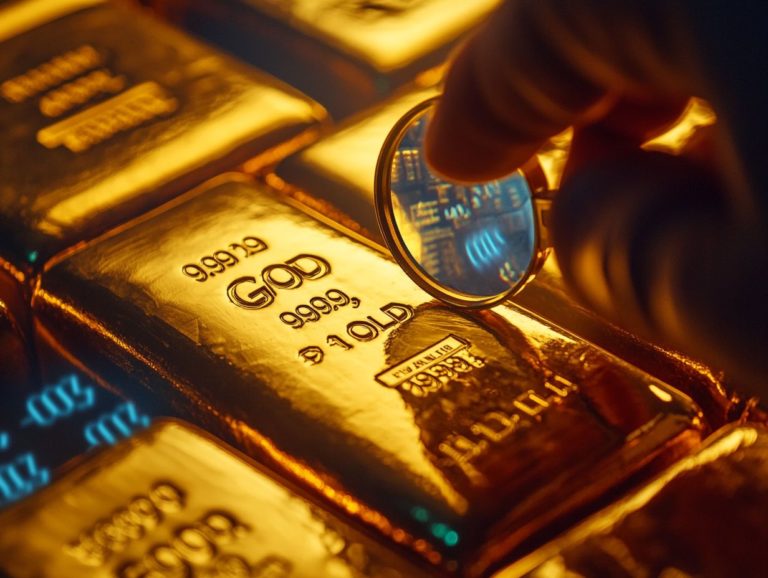Gold Mining Trends: Impact on Prices
Gold mining plays a vital role in global economies. It is also a key part of many investment strategies.
Explore the current state of the gold mining industry. Discover how various factors impact gold prices, including supply and demand, economic conditions, and geopolitical tensions.
Consider how mining practices shape production costs while affecting the broader social and environmental landscape.
Future trends and potential influences on gold prices will be explored, providing you with a comprehensive understanding of this vital sector.
Join us on this thrilling journey through the gold mining world!
Contents
- Key Takeaways:
- Overview of Gold Mining Trends
- Factors Affecting Gold Prices
- Impact of Gold Mining on Prices
- Future Outlook for Gold Prices
- Frequently Asked Questions
- What are the current trends in gold mining and how do they impact prices?
- How does the use of new technology in gold mining affect prices?
- What role do geopolitical factors play in gold mining trends and prices?
- How does the environmental impact of gold mining affect its prices?
- Are there any social issues associated with gold mining that can affect prices?
- How can investors stay informed about gold mining trends and their impact on prices?
Key Takeaways:

- The current state of the gold mining industry significantly impacts gold prices, as fluctuations in production and supply can greatly affect market dynamics.
- Global economic conditions and geopolitical factors play a crucial role in determining gold prices, creating fluctuations in demand and investor sentiment.
- The increasing focus on environmental and social factors in gold mining can impact prices, affecting production costs and supply in the long term.
Overview of Gold Mining Trends
The gold mining industry has undergone notable transformations in recent years. These changes are shaped by a myriad of factors, including mining production, heightened recycling efforts, and the intricate dynamics of overall gold supply.
Countries like China, Australia, and South Africa maintain their status as key players in gold mining. The relationship between gold demand, investment appetite, and prevailing market conditions has grown increasingly significant.
Mining companies face operational challenges and environmental considerations that may influence quarterly reports and gold prices in the near future. This is particularly true in developed markets where inflation rates are on the rise.
Current State of the Gold Mining Industry
The current landscape of the gold mining industry presents a dynamic picture, marked by fluctuating production levels. Countries like China, Russia, and Australia lead not only in gold extraction but also in navigating production costs. Central banks play a crucial role in influencing gold prices.
As these nations increase their mining activities, they encounter various operational challenges. Energy costs can fluctuate wildly, and regulatory changes may swiftly impact profitability. Gold extraction often relies on intricate processes, such as using chemicals to extract gold and smelting, which face pressures from environmental regulations and technological advancements.
Central banks actively manage their reserves, engaging in buying and selling gold to stabilize market conditions.
This interplay between mining operations and economic factors like labor costs and geopolitical tensions shapes production levels and the complex dynamics of gold pricing globally.
Factors Affecting Gold Prices
Several factors intricately influence gold prices. Gold demand, inflation rates, and interest rates are crucial variables.
During times of economic uncertainty and market upheaval, investors often gravitate toward gold, viewing it as a reliable safe haven asset.
Supply and Demand Dynamics
The dynamics of supply and demand in the gold market are complex and influenced by a variety of factors. Seasonal fluctuations in jewelry demand, industrial needs for consumer goods, and a rising emphasis on gold recycling all play pivotal roles in shaping the landscape.
These seasonal patterns often peak during festivals or wedding seasons, especially in regions where gold jewelry is highly prized. Industrial applications from electronics to dentistry require a steady supply, directly impacting market availability.
As you become more aware of sustainability, you ll see how gold recycling is gaining traction. Repurposing old gold not only bolsters the primary supply but also reduces the need for new mining.
This delicate balance contributes to the overall stability of the gold market, underscoring its significance as both a commodity and a valuable investment.
Global Economic Conditions

Global economic conditions include trade tensions, inflation, and interest rates. These factors significantly impact the gold market’s demand and supply.
As central banks navigate economic uncertainty, they strategically manage their gold reserves. When financial markets show signs of volatility, these institutions often boost their gold holdings, seeing it as a safe investment.
In times of rising geopolitical tensions or escalating inflation, investors flock to gold, not just for wealth preservation but also to protect against currency devaluation. This surge in demand can lead to supply constraints, pushing gold prices higher.
On the flip side, in a stable economic climate, diminished demand from central banks and investors can create a surplus, disrupting market equilibrium.
The interplay of these factors weaves a complex tapestry that perpetually shapes the gold market.
Geopolitical Factors
Geopolitical factors, such as rising tensions among major players like China, Russia, and the United States, create significant market turmoil. As an investor, you ll likely want to seek refuge in gold, often viewed as a reliable safe haven asset.
When political climates shift unexpectedly think trade disputes or military escalations central banks may adjust their monetary policies to stabilize their economies. This reaction can quickly spark a surge in demand for gold, driving prices higher as both individuals and institutions rush to protect their wealth.
Take, for example, the uncertainty surrounding Brexit. It led to a substantial increase in gold purchases, reflecting investors’ anxieties about potential economic fallout. Additionally, fluctuations in interest rates or currency values, often influenced by geopolitical tensions, can entice market participants to gravitate toward gold, enhancing its appeal as a hedge against volatility.
Impact of Gold Mining on Prices
The impact of gold mining on prices is complex and layered. Various factors, such as production costs, operational challenges, and environmental concerns, directly influence the overall supply of gold.
This, in turn, shapes market conditions and affects gold prices.
Production Costs and Supply
Production costs in gold mining are shaped by numerous factors, such as labor, technology, and inflation rates. All of these influence the global supply of gold and the profitability of mining enterprises.
The intricate balance of these costs dictates the feasibility of exploration and the sustainability of ongoing operations. When wages rise, margins can be squeezed, compelling companies to innovate or embrace more efficient technologies to manage expenses.
Fluctuating energy prices and the need for equipment maintenance complicate financial forecasting, often leading to more conservative investment decisions. In today s economic landscape, where the demand for gold often mirrors broader economic indicators, mining companies must continuously refine their strategies to stay competitive, enhancing operational efficiency or diversifying their portfolios to effectively hedge against market volatility.
Environmental and Social Factors
Environmental and social factors significantly influence gold mining. Mining companies find themselves under heightened scrutiny regarding their practices and operational challenges. This scrutiny can ultimately impact both the gold supply and consumer demand.
Growing concerns about ecological degradation and disruption to local communities have spurred an increased demand for responsible sourcing practices. Stakeholders are becoming more aware of the adverse effects of careless mining operations. This awareness is fueled by a desire for sustainable products that meet ethical standards.
Regulatory frameworks and community engagement initiatives are gaining momentum. This is pushing companies to adapt and showcase their corporate responsibility.
When navigating the market, you’ll notice that consumers increasingly favor companies that prioritize environmental stewardship and social equity. These shifting dynamics have the potential to reshape market trends. They influence not only the valuation of gold but also its acceptance among discerning buyers.
Future Outlook for Gold Prices

The future outlook for gold prices hinges on a tapestry of predictions and forecasts that consider a multitude of factors. You ll want to consider market conditions, inflation rates, and the pivotal role central banks play in managing gold reserves and influencing investment demand.
Understanding these elements will help you understand the gold market better.
Predictions and Forecasts
Predictions and forecasts for gold prices hinge on current market conditions, investment demand, and broader economic uncertainties. These uncertainties often drive investors toward safe-haven assets like gold.
Industry experts employ a range of methodologies to craft their projections. They tap into technical analysis, historical price trends, and economic signs that show how the economy is doing. By scrutinizing factors such as inflation rates, interest rates, and geopolitical tensions, analysts can discern market sentiment and anticipate potential fluctuations in gold prices.
Investment trends, like shifts in central bank policies or rising retail interest in gold ETFs, play a significant role in shaping these forecasts. Grasping these dynamics gives you the power to make informed decisions in an ever-evolving financial landscape. This positions you to capitalize on price movements in this cherished commodity.
Potential Influencing Factors
Several factors could change gold prices. These include shifts in inflation rates, new geopolitical developments, and the strategic actions of central banks responding to changing market conditions.
As a market participant, you’ll want to keep a close eye on how these dynamics interact. Rising inflation can enhance gold’s appeal as a hedge against eroding purchasing power. When significant geopolitical tensions arise, you may notice investors flocking to gold, as it has historically been viewed as a safe haven during turbulent times.
Simultaneously, the decisions made by central banks whether tightening or loosening monetary policy can create ripple effects throughout the economy. This impacts not just gold prices directly but also the broader financial landscape you navigate. By understanding these interconnected elements, you can better navigate potential volatility and make informed decisions in a fluctuating market.
Frequently Asked Questions
What are the current trends in gold mining and how do they impact prices?
Currently, gold mining trends are shifting towards sustainable and ethical practices. This leads to higher production costs, which can potentially influence prices. The rise of digital currencies has also affected demand for gold, impacting its value.
How does the use of new technology in gold mining affect prices?

New technology in gold mining allows for more efficient and cost-effective extraction methods. This can potentially lead to increased supply and lower prices. However, it may also lead to a decrease in the overall quality of gold, which can impact prices in the long run.
What role do geopolitical factors play in gold mining trends and prices?
Geopolitical factors, like economic instability and political uncertainty, greatly influence gold prices. During crises, investors flock to gold, driving up its demand and prices.
How does the environmental impact of gold mining affect its prices?
The environmental impact of gold mining includes pollution and habitat destruction. Stricter regulations and rising production costs can ultimately affect gold prices.
Consumer demand for ethically sourced gold also plays a crucial role in influencing prices.
Yes, issues like labor rights, health and safety concerns, and child labor create negative perceptions that can reduce consumer demand. Companies that embrace ethical practices are winning in the market!
How can investors stay informed about gold mining trends and their impact on prices?
Investors should monitor industry news and reports, along with economic and geopolitical developments. Consulting with a financial advisor helps investors make informed decisions based on market trends.














